How To Achieve Over 90% Capture Rate With Optos/Eidon Widefield Script
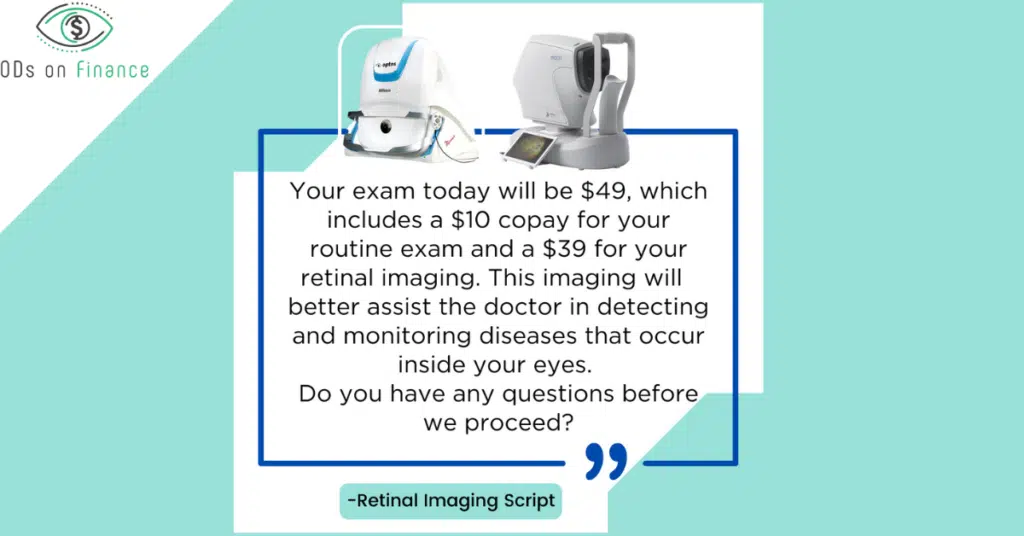
As practitioners, we understand the importance of retinal imaging, and we need to be able to clearly explain that value to our patients.
I’ve found that communication is key with patients — before, during, and after their appointments. This helps to eliminate any questions, and it ensures that they’re not only on board with the testing, but they understand why you’re doing it, what to expect, and how much it will cost. By taking the time to properly train your office staff to be able to prep patients ahead of time and answer their questions, it will help you increase your revenue.
Prior to Appointment:
I’ve developed a script that I provide my office staff to help guide them through conversations with patients over the phone every step of the way. This prepares patients for the retinal scan, and it also includes information on exactly how much it will cost. These conversations typically go as follows:
Front Desk: "Your appointment is scheduled with Dr. Bui. Typically, your exam fee, including retina screening, would be $180, but with your insurance, your out-of-pocket cost is $49."
At this point, 95% of calls usually conclude.
Patient: "What does the $49 payment cover? My copay was only $10 last year."
Front Desk: "Your exam copay is indeed $10, but our doctors require all patients to undergo a $39 retina screening with our Eidon (or Optos) wide-field. This is crucial to detect health conditions related to the eye, such as hypertension, cholesterol, diabetes, and other potential vision-loss diseases."
Note: This explanation satisfies 99% of callers. While many conversations end with this information, some patients do have more questions, especially if their copay was cheaper at their last exam.
Patient: "Well, I don't want to pay the extra $39 copay."
Front Desk: "Understood. Let’s proceed with scheduling your appointment, and you can discuss your options directly with the doctor during the exam."
This explanation is likely to satisfy most patients, but for those who may fight back against the $39 copay, we instruct our front office staff to keep their appointment scheduled and explain that I will discuss their options with them in-office.
Clinical Pearl
There’s no need to explicitly mention the $150 Exam + $39 Retina Optos, but this information can be shared with the patient if they inquire.
Day of Exam:
When the patient checks in for their exam, it’s important to reiterate the previous phone conversation: the exam fee with the retinal screening is typically $180, but the out-of-pocket cost with insurance will be $49.
Front Desk: "Thank you for checking in. As mentioned on the phone, your appointment is scheduled with Dr. Bui. Typically, your exam fee, including retina screening, would be $180, but with your insurance, your out-of-pocket cost is $49."
At this point, 99% of interactions usually conclude.
Techs automatically perform retina wide-field on every patient, leaving the decision to charge or not to Dr. Bui.
Tech: "Your Retina scan looks really good. Dr. Bui will review your images during your exam."
Before I meet with the patient, I’ll have the tech give them a teaser on their retinal imaging results, without reviewing them, to create a sense of excitement and add value.
Clinical Pearl
If the patient isn’t keen on spending the money on the retinal exam, I still encourage my techs to perform the test anyway. I can make the final decision on whether or not to charge the patient for the exam. Usually a patient will listen to a doctor vs a technician.
For your first year during any transition, I give my ODs the option to waive the $39 fee if there is any serious pushback. In my experience, this has been rare. During our first year, we were at 95% acceptance, and now we are at 100%.
Doctor’s Exam:
When it’s time for me to meet with the patients, I always go over the game plan with them to eliminate any surprises. This makes your patient less stressed out and cooperative during the process, and they leave happy. I’ll say something like the following:
Dr. Bui: “Based on your issues and chief complaint today, I am going to check out your vision and glasses to make sure you are seeing well at distance, near, and intermediate. Based on that, we will see if we need to adjust your contact lens prescription. Then, I will check the health of the front of the eyeball to make sure there is no dryness. Lastly, I will take a look at your retinal scan to make sure there is no disease back there. We probably don’t have to dilate unless I see something suspicious on your retinal scan. Any questions before we get started?”
Clinical Pearl
Always go over your game plan before starting. This makes your patient feel happy, cooperative during the process, less stressed out, and they leave happy getting everything they want.
Clinical Pearl
Refraction: I personally do NRA/PRA; it is a simple 10s test that determines if my patient needs comp RX or not based on their accommodative issue. All my Apple patients will get a 2nd SV Comp pair.
Trial Frame: I always TF my SV Comp with a holder in front of my desk (have the patient sit down); it is an easy sale. But for efficiency/time saving, I will TF Distance & compare to Habitual behind the automatic phoropter.
Dr Bui: "Looks like your ability to focus up close is a little reduced! Welcome to Apple, right? HAHA. Bad joke, but it is kind of true."
(Insert Corny Joke) 100% of them will laugh and think about getting SV COMP now.
(After refraction, reinforce the retina scan)
Dr. Bui "Great job on your refraction test; I know that is usually stressful for a lot of patients. By the way, your retina scan quality came out great; I will show you in just a little bit after I take a look at it myself with my special lens."
Note: I take a peek undilated with 90D; I also can do peripheral 90D undilated to get a closer view sometimes too. I will spend the most time, a minimum of 5-10 mins, going over findings/treatment/education to reinforce the value of the retina scan.
Dr. Bui: “Your retinal blood vessels look great, no sign of hypertension, cholesterol, or diabetes. This is your macula; that is what gives you that crisp 20/20 vision, nice and clear! Just make sure you wear sunglasses to protect yourself. Your optic nerve looks great, no sign of glaucoma. Your retina looks great, no tears or bleeding out there. Nice clean bill of health. I will see you back next year. I will take another scan next year so we can compare it to today’s for any ocular changes. Any questions for me before you take off?”
At this point, most patients are amazed by how comprehensive the exam was, and the value of the retinal scan is instantly clear to them.
Tips/Common Questions:
- You can make it mandatory as a part of your standard fee, or leave it optional. Either way, the high capture rate (over 90%) is due to how you present it via Script.
- This is a CASH PAY SCREENING, so we use Fundus Photos 92250 Mod-52 to document it; otherwise, any S-Code works. There are some VCP plans that will pay for it—$39 (rare)—so check prior, but 90% of the time, it is the patient’s responsibility.
- Work in ALL modalities of practice, from high-end practice to corporate, to low-income Medicaid practice. I’ve worked in all types and have helped ODs establish this. Surprisingly, low-income clients often have the LEAST resistance because they value their health. Rich people are often the cheapest.
- Will some VCP or Medicaid plans restrict you from making it a requirement? That is going to be up to you; it is a cash service, aka elective procedure. Does medical insurance stop you from selling cash services on top? Nope! Remember, in an audit, you can argue that this is my standard of care (and 50K+ ODs would agree) that wide-field imaging is optimal for the best care.
- SAY LESS, MAKE IT A Routine part of your standard of care. You are not selling anything. If they refuse, then good, it weeds out all of the cheap patients that you don’t want to see anyway. DO NOT NEED A WRITTEN CONSENT, everything is done verbally
- Remember, similar to an X-Ray or dental fluoride, this is not an optional test; it is a part of my highest standard of care. But I understand it is challenging in the first year because we are re-training our patient behavior.
- Practice Revenue: $39 Cash x 15 exams = $585 x 6 days x 52 weeks = Over $182,520 in Gross profit Annually.
What I Normally Do & Other Clinical Tips:
- I have personally used both wide-fields before. Optos Ultra Wide-field is the only one-shot image that can have up to 200 degrees view (the newer model Monaco has OCT Screener)*, this is great for primary care optometrists who are looking for a quick and easy way to screen patients for retinal disorders. While the Eidon Wide-field can get up to 200 degrees but does require a 3-shot automatic Mosaic (usually high quality).
- II always require mandatory widefield screening, regardless of whether patients have an OMD or not. My patients always appreciate the second point of view and through explanation.
- For Healthy Patients: I will dilate first-time patients if they have never had a DFE before, as a baseline. However, for the majority of my healthy patients, I don't dilate. I usually perform a routine dilation every 4-5 years for them (most are comfortable with this since it has been a while).
- For High-Risk Patients: Naturally, for my diabetic or high myopic patients, I dilate more often, every 1-2 years, along with a yearly retina scan.
- During Transition: In the first year during any transition, I give my AODs the option to waive the $39 fee if there is any pushback. Rarely, during our first year, we had 95% acceptance, and now we are at 100%.
- Not dilating patients allows me to do more complicated MF CL fittings the same day. I always finalize the same day for basic SCL/Toric and even MF if I get good results. They will always message me back via email if there are any issues. CL check follow-ups are a waste of everyone's time.
- I rarely have patients come back just for DFE follow-ups. We either do it the same day, or we can defer it to next year. Patients usually don't show anyway. If it is urgent, then it is likely medical anyway, so I have them come back for a MEDICAL RETINA Level 4 with Retina Photos and charge their medical insurance.
- I spend around 8-10 minutes on OBJECTIVE tests and the majority, 8-10 minutes, on patient education.
- Mandatory Retina screening allows for a 20-minute exam, but I usually find 30 minutes is the sweet spot to avoid doctor burnout.
- This might seem simple, but I get the most "WOW factor" from my tech worker. I use my iPad for near testing (I literally take a photo of my near card) and I use EyeDock for all anterior/posterior patient education & CL CALCS. It's the easiest investment ever. EyeDock Partner
Conclusion
Talk with confidence and a casual tone when presenting it to your patients. Remember that you never have to sell anything as a medical doctor; this is your standard of care and how you want to practice.
Lastly, as a financially focused optometrist, all of your equipment purchases should generate an impressive return on investment, leading to higher profits and better business outcomes. Check out our conservative revenue breakdown for popular equipment below.
Want To Get The Best Discount deals for Eidon and Optos Ultra-Widefield? Check Out ODoF Equipment Group Buy (Below)
*Optos is the industry leader in imaging in optometry & ophthalmology. They offer the only true ultra-widefield retinal imaging devices. They are the only company that can capture up to 200 degrees of the retina in one single image. Their UWF Monaco device also includes integrated OCT. A new option with their California device is the Color RGB (red/green/blue) modality, in addition to its existing Color RG.

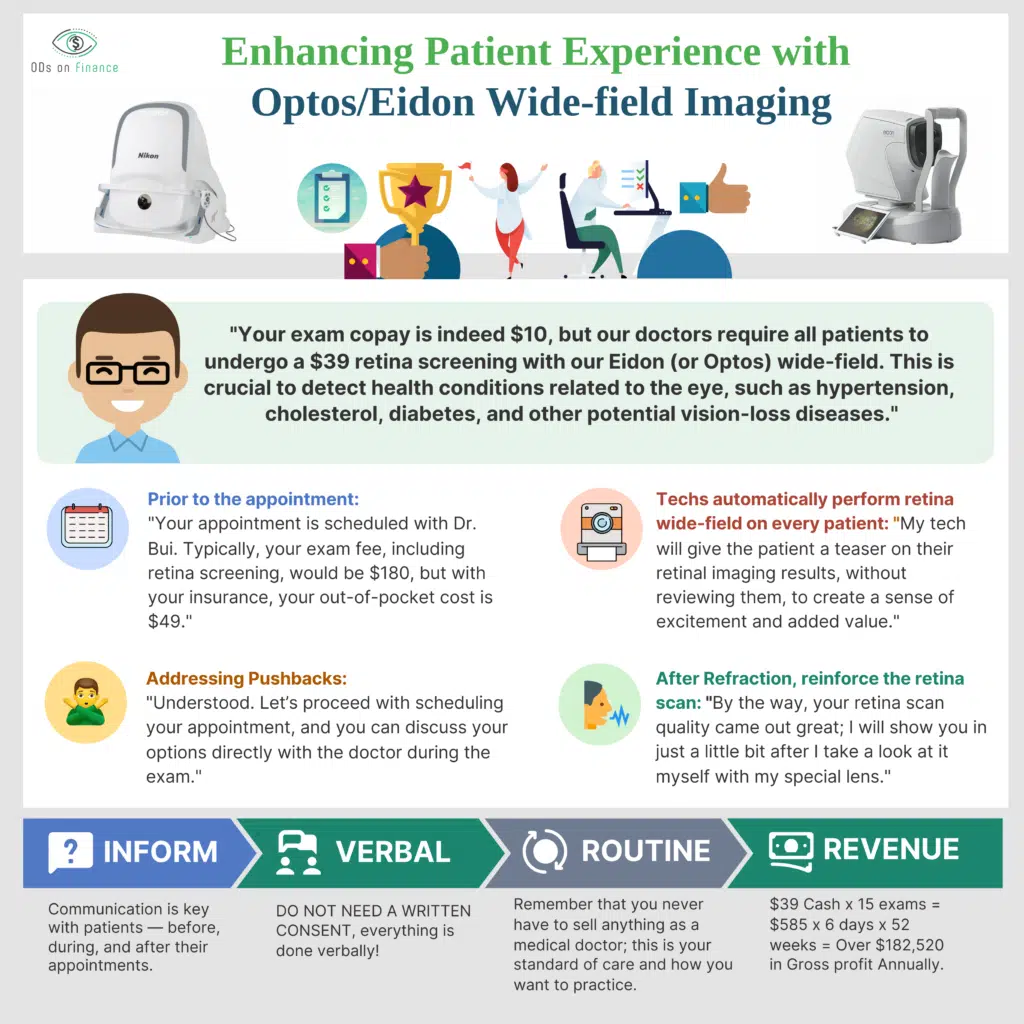
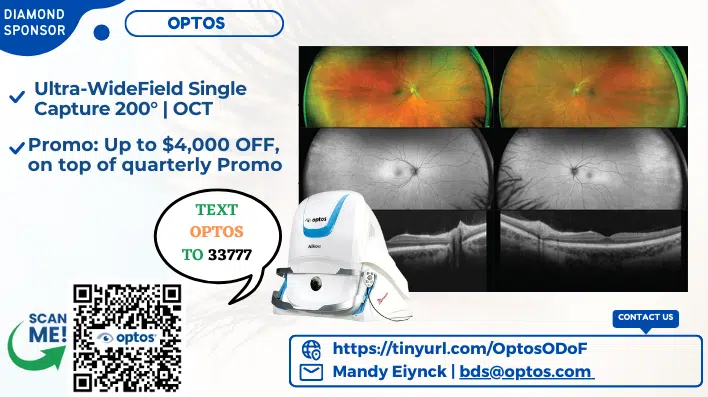
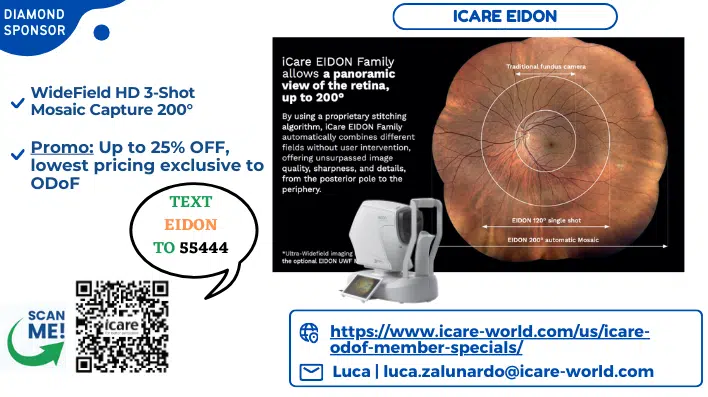
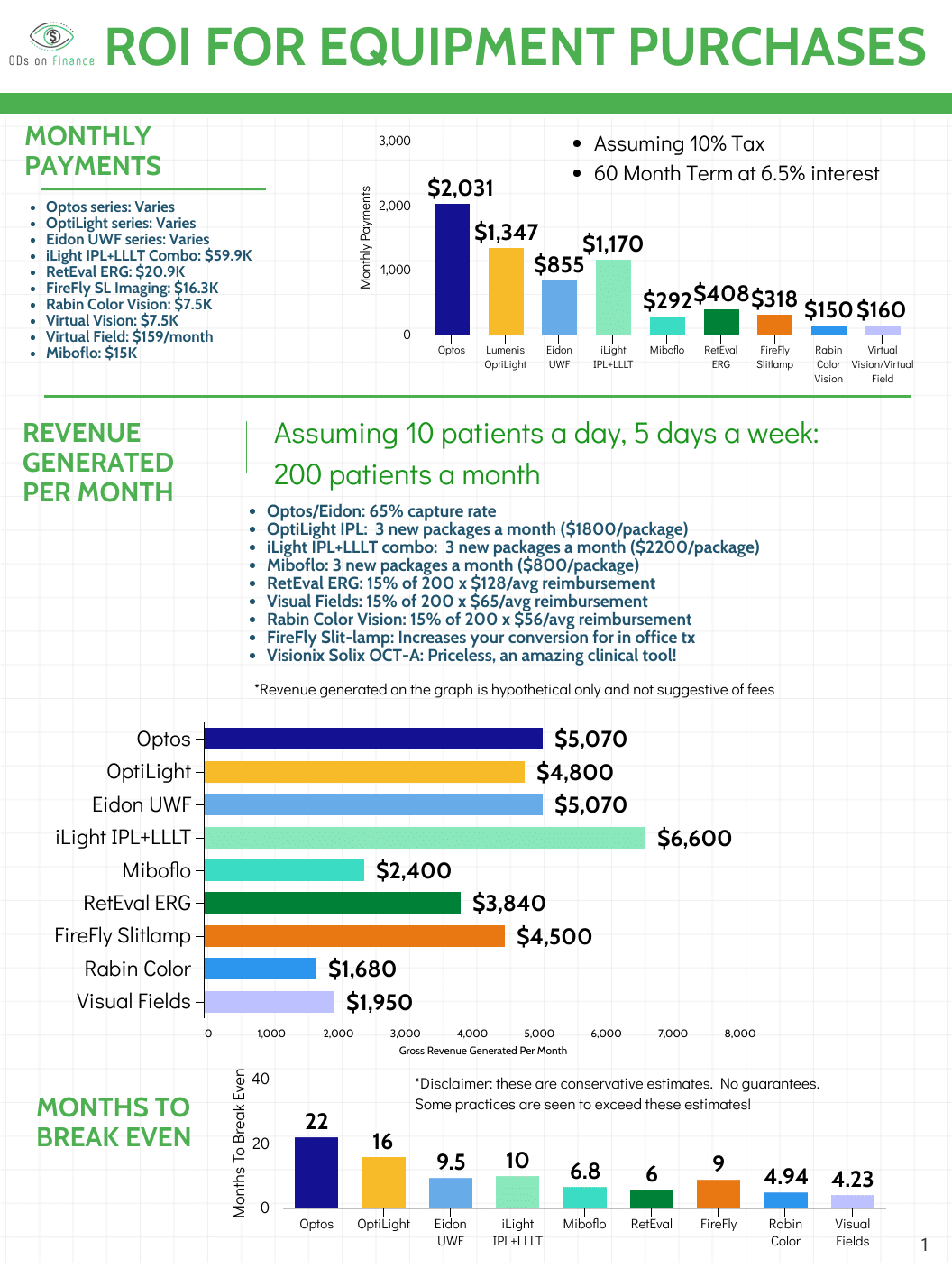
If you have someone that presents with a medical diagnosis found on Optos screening, can you bill their medical with a cpt code 92250 ?